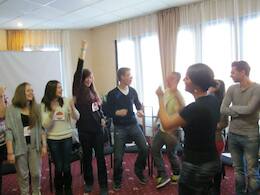Toolbox — For Training and Youth Work
All new tools in your inbox: Be the first to know about new tools for learning with our e-mail notifications.
Group Building Activity
Play S.M.A.R.T. Basketball
Uses - This activity can be used for general training sessions, team building, or any group evaluation task.
Time: Twenty to thirty minutes
Aims of the tool
Objectives
• To evaluate and choose group goals
• To motivate participants to consider group goals in a more structured way
Description of the tool
Procedure
1. Prior to the meeting, write the words: “Specific,” “Measurable,” “Achievable,” “Relevant,” and “Timely” in large block letters on separate sheets of paper. Make the first letter in each word about twice the size of the other letters, in red or a color different from the rest of the letters. Tape the sheets to five wastebaskets, one sheet per wastebasket.
2. Place the wastebaskets in a row in front of the group so that the letters read S.M.A.R.T. Explain that this activity is designed to help the group evaluate and choose goals.
3. Have the group brainstorm a list of at least ten team goals or other goals relevant to their group or organization (or use an existing list) and write them on the flip chart.
4. Help them to discuss the goals for clarification and to make any needed changes. Be sure that everyone has basically the same definition of each goal.
5. Distribute five balls (or colored paper balls) and one copy of the S.M.A.R.T. Goal Setting Handout to each participant.
6. Have the participants read the “S.M.A.R.T.” criteria and answer any questions they may have about their intended meaning. Point out that the first letter of each word on the wastebaskets represents those five criteria, S.M.A.R.T.
7. Read the first goal that is listed on the flip chart. Tell participants to evaluate it
by simultaneously tossing balls into the wastebaskets representing the criteria it meets. For instance, if a participant believes a goal is “specific,” “achievable,” and “timely,” he or she would toss three balls, one into each respective wastebasket.
8. After the goal has been “evaluated,” count the number of balls in each basket and record the total on the flip chart.
9. Repeat Steps 7 and 8 for the remaining goals. Declare the best goals to be those with the highest total points.
Discussion
Discuss this technique for setting goals and evaluating them, as well as the rating for the goals by using the following questions:
How well did this activity work for evaluating your goals?
Did you notice a tendency to toss balls into baskets already containing balls? Why did that happen?
Did you take this form of evaluation as seriously as more traditional approaches? Why or why not?
In what ways could this approach improve group evaluations?
Did everyone understand the criteria? If not, what could have been done to increase your understanding?
Disclaimer
SALTO cannot be held responsible for the inappropriate use of these training tools. Always adapt training tools to your aims, context, target group and to your own skills! These tools have been used in a variety of formats and situations. Please notify SALTO should you know about the origin of or copyright on this tool.
Tool overview

http://toolbox.salto-youth.net/1927
This tool is for
All levels, in groups of four to seven
and addresses
Project Management
It is recommended for use in:
Training and Networking
Materials needed:
Handouts, Materials, and Equipment
• Six small office wastebaskets or cardboard boxes
• Five balls for each participant or sheets of colored paper wadded into balls
• One copy of the S.M.A.R.T. Goal Setting Handout for each participant -
S.M.A.R.T. Goal Setting Handout
Instructions: Use the following list of criteria to evaluate each of the group’s goals. Consider whether each goal is:
Specific
Does it specify exactly what is desired? Is it clear?
Measurable
Can it be measured objectively? Will success be obvious?
Achievable
Is it realistic to expect your group to achieve this goal?
Relevant
Does the goal pertain to the team (or organizational) mission and values?
Timely
Is this goal appropriate at this particular time?
• A flip chart and markers
• Masking tape
Duration:
Twenty to thirty minutes
Behind the tool
The tool was created by
Kirilka Angekova
in the context of
Creativity camp for students
The tool has been experimented in
Training course
The tool was published to the Toolbox by
Kirilka Angelova (on 30 January 2017)
and last modified
11 October 2016
Comments
No comments have been posted yet.
If you want to comment on this tool, you need to be signed in with your MySALTO account. Sign in now